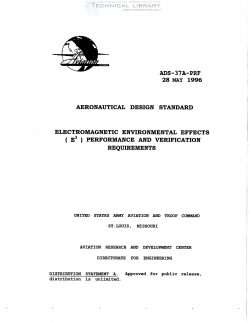ADS-37A-PRF
- Version
- 367 Downloads
- 1.26 MB File Size
- 1 File Count
- February 9, 2017 Create Date
- February 9, 2017 Last Updated
Aeronautical Design Standard, United States Army Aviation and Missile Command - Electromagnetic Environmental Effects Performance and Verification Requirements

Lightning Environment (Direct Effects Testing). For design and verification purposes, the natural
lightning environment (which comprises a wide statistical range of current levels, duration, and number of
strokes) is represented by current components A through D, and voltage waveforms A, B, and D as defined
in paragraph 23.5 of RTCA/DO—I6OC. Guidance for application of these waveforms is also given in
Section 23 of RTCA/DO-I6OC.
Lightning Environment (Analysis and Indirect Effects Testing). Appendix III of FAA/AC 20-136
contains idealized mathematical representations of a severe natural lightning environment. Those
waveforms A, B, C, and D are derived from cloud-to-ground lightning discharges. Waveform H represents
the high rate—of-rise effects including those from intracloud and cloud-to-cloud discharges. These idealized
waveforms can be used as the bases for either tests or analyses of the effects of a severe lightning
environment on aircraft electrical/electronic systems. Test waveforms, of necessity, will be only
approximations of the idealized waveforms. Results from test waveforms that deviate from the idealized
waveforms must therefore be analytically relatable to the idealized waveform.
Lightning Attachment Zones. Lightning attachment zones are defined in paragraph 23.2.3 of RTCA/DO—
160C. Guidance for locating the zones on particular air vehicles is discussed in the Section 30.1 of MIL—
STD-1795.
Lightning Effects (Direct and Indirect). The direct effects of lightning are the burning, eroding, blasting,
and structural deformation caused by lightning arc attachment, as well as the high pressure shock waves and
magnetic forces produced by the associated high currents. Direct effects includes the direct coupling of
lightning currents into electrical wiring associated with external lighting, antennas, and other external
equipment. The indirect effects are those resulting from the interaction of the electromagnetic fields
accompanying lightning with electrical/electronic equipment inside the vehicle.
Flight Critical Equipment. E3 generated anomalies involving this equipment would cause immediate or
almost immediate loss of aircraft control or unsafe situations with loss of life a likely occurrence.
Flight Essential Eguipment. E3 generated anomalies involving this equipment could cause an emergency
landing with possible damage to the aircraft, or would cause the pilot to take other emergency action.
Injury or loss of life is possible.
| File | Action |
|---|---|
| ADS-37A-PRF Electromagnetic Environmental Effects Performance and Verification Requirements.pdf | Download |

Comment On This Post